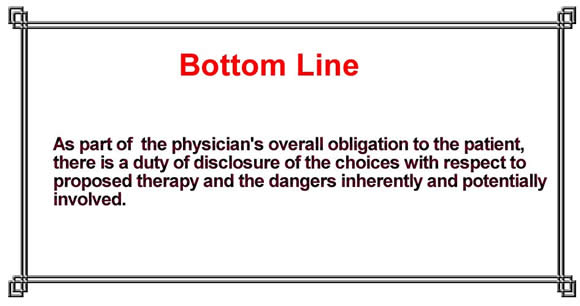Informed Consent
Informational Duty
Most informed consent cases sound in “negligence.”
- Was the disclosure adequate?
- Did the patient prior to giving consent receive the amount and the type of information they needed to make an informed decision about whether or not to have the medical procedure?
Examples of two relevant cases:
Irma Natanson, Appellant, v. John R. Kline (1960s in Kansas).
First case to assess the adequacy of disclosure (how much information was given).
The patient had breast cancer and was given high dose radiotherapy to the chest wall resulting in destruction (radiation necrosis) of the entire chest wall (skin, bone and cartilage).
In reading through the case, a high dose of radiotherapy was given over a short period of time which would be likely to be associated with chest wall damage. Radiation planning techniques at that time were in their infancy.
The doctor had not warned her about any risks or adverse side effects associated with radiation therapy (he failed to make any disclosure).
“A physician violates his duty to his patient and subjects himself to liability if he withholds any facts which are necessary to form the basis of an intelligent consent by the patient to the proposed treatment. Likewise the physician may not minimize the known dangers of a procedure or operation in order to induce his patient's consent”.
Hopp vs Lepp (1980 - Supreme court judgment).
Hopp v. Lepp, [1980] 2 S.C.R. 192
Canadian informational duty is based on Hopp v Lepp.
An orthopedic surgeon working in a small non-academic center performed disc surgery (L3/4). A formal signed informed consent was obtained for hemilaminectomy.
Subsequently, the patient was not improving as expected. A blockage was found to still exist and the patient was referred a neurologist in larger academic center.
Neurosurgeon from that larger center had to perform extensive decompressive laminectomy from the second to the fifth lumbar vertebrae. At surgery a large chunk of extruded disc material between the third and fourth lumbar vertebrae was found and removed.
The patient was left with permanent disability and sued the surgeon for damages sounding in negligence and in battery.
Trial court: Dismissed action for negligence
Court of Appeal: The action for negligence was dismissed. However the court, by a majority, allowed the appeal, holding that the consent given to the operation was "not an informed consent" and hence there was an unlawful invasion of the respondent's bodily security, a battery or assault. Damages awarded of $15,000. The action for negligence was dismissed.
Supreme Court: Held that prior consent by a patient to surgery/therapy doesn't make a surgeon or physician immune from liability for battery or negligence if he/she failed in duty to disclose risks of surgery – known to physician but not to patient.
Three aspects of informed consent were addressed:
1. Was the surgeon under an obligation to tell the patient that this was the first time he had ever done such surgery after obtaining his licence?
- The trial judge held that the surgeon was fully qualified and was under no obligation to tell the respondent that this was his first operation, when it was clear that he was not inexperienced.
2. Was there a duty on the surgeon to say that if there were complications he would not be able to call on any neurologist or neurosurgeon in the small center, because there were none there at the time?
- The trial judge held that although there was a possibility of complications as there is in any operation, there was no probability of that, and where there is no special or unusual risk involved, the surgeon or physician is not obliged to alert the patient.
3. What is the duty of disclosure of the surgeon with respect to the seriousness of the operation?
- Surgeon did not tell patient that the operation was serious
- Main issue argued at court
Hopp vs Lepp referred to a US case:
Jerry W. CANTERBURY v. William Thorn SPENCE 1970s.
“A youth troubled only by back pain submitted to an operation without being informed of a risk of paralysis incidental thereto. A day after the operation he fell from his hospital bed after having been left without assistance while voiding. A few hours after the fall, the lower half of his body was paralyzed, and he had to be operated on again. Despite extensive medical care, he has never been what he was before. Instead of the back pain, even years later, he hobbled about on crutches, a victim of paralysis of the bowels and urinary incontinence.”
The appellate court found that in the fiduciary qualities of the physician-patient relationship, it was the physician's duty to reveal to the patient that which was in his best interests and it was important that he should know.


